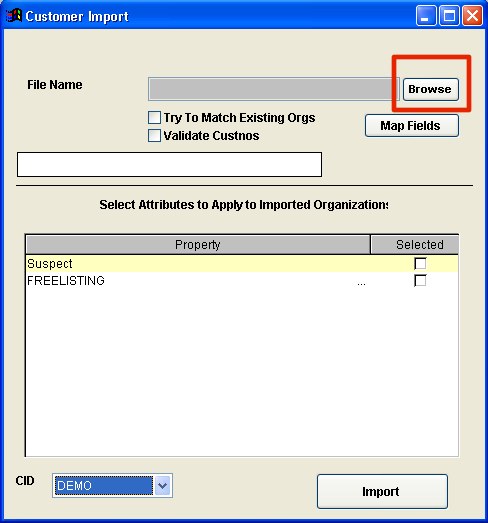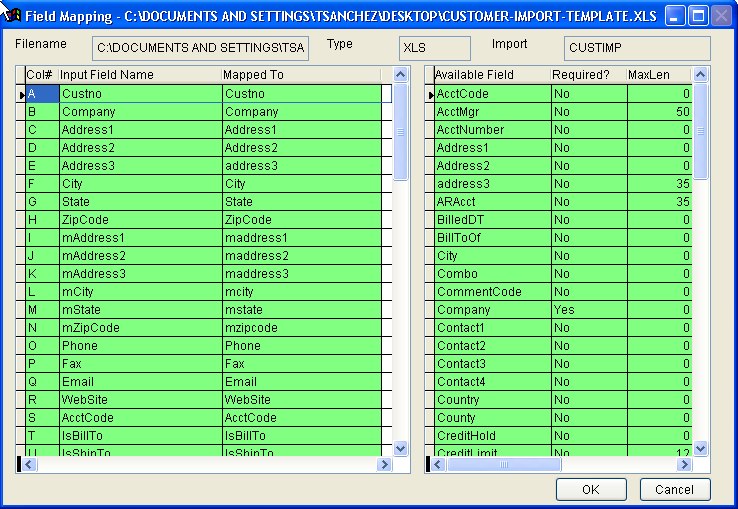Page History: Customer Import
Compare Page Revisions
Page Revision: Thu, 28 Jul 2011 12:18
General Info
Default Menu Location: Transaction >> Importers/Exporters >> Address Book >> Customer Import
Screen Name: IMPORTCUST
Function: Import new customers and update existing customers. This tool can also be used to import Ship To records.
Click here for a screenshotRequired Spreadsheet Format
Customer Import Template FileTo avoid any formatting issues, it is advised to save the spreadsheet in Microsoft Excel 5.0/95 Workbook Format.
Filters/Fields
File Name: The file being imported into Adjutant. Click the
Browse button to locate and select the file.
Map Fields: Click this button to map the column headers in the spreadsheet to the data fields in the Adjutant database.
Try To Match Existing Orgs: Check this box to turn on additional logic that looks through your existing customers in Adjutant and tries to match each record in the spreadsheet with one in Adjutant. If the import program finds a match, it will update that customer's information with the info in the spreadsheet.
Validate Custnos: Check this box if you have Customer IDs (Organization IDs) in your spreadsheet and you want to update your existing customer records based on ID. This is commonly used if you export your customer database to do some mass updates in Excel and then want to import that data back in to Adjutant.
Attributes: You can assign attributes to all of the organizations in the file by checking any of the attributes in the list.
The list is limited to attributes in the Organization Attributes rule that have the
Show in Import flag checked.
Click here for an example.
Spreadsheet Explanation
Custno - Organization ID
Company - Name of Company/Organization
Address1 - Physical Street Address
Address2 - Physical Address 2 (apt/suite number)
Address3 - Physical Address 3
City - City name
State - State abbreviation
ZipCode - Zip Code (you can use zip+4 if you have it)
mAddress1 - Mailing Street Address
mAddress2 - Mailing Address 2 (apt/suite number)
mAddress3 - Mailing Address 3
mCity - Mailing City
mZipCode - Mailing Zip Code
Phone - Main phone number
Fax - Main fax number
Email - Main email address (use the address that invoices will typically be sent to)
WebSite - website address
AcctCode - If you're connecting to another accounting system, enter the customer ID in that system.
IsBillTo - Enter a 'y' if this organization is a billing address.
IsSoldTo - Enter a 'y' if this organization is a customer.
Contact1 - Default Contact for the organization. This will list them as the contact on the organization and make a contact record listing them as the default contact.
Title1 - Default contact's job title.
AcctMgr - Account Manager's name. This must match the full name of a contact with the Account Manager attribute.
Sp - Salesperson's name. This must match the full name of a contact with the Salesperson attribute.
FOB - The default FOB terms. This is only applicable for Ship To records. This must match a value in the FOB rule.
Freight - Freight payment terms. This is only applicable for Ship To records. This must match a value in the FREIGHT rule.
ShipVia - Shipping method. This is only applicable for Ship To records. This must match a value in the SHIPVIA rule.
Contact2/3/4 - Contact name.
Title2/3/4 - Contact's job title.
Phone2/3/4 - Contact's primary phone number.
Email2/3/4 - Contact's email address.
Country - Name of country.
County - No longer used. Leave this field blank.
TaxExempt - Enter a 'y' if the customer is tax exempt.
TaxExemptNum - Tax Exempt number.
Credit Hold - Enter a 'y' if the customer is currently on credit hold.
CreditLimit - Enter the customer's credit limit.
DNECredit - Enter a 'y' if nobody is allowed exceed the customer's credit limit.
TaxRate - No longer used. You can leave this field blank.
Terms - Default payment terms. This must match a value in the TERMS rule.
CustCat - Customer Transaction Category. This must match a value in the CUSTCAT rule.
Terr - Sales Territory. This must match a value in the TERR rule.
GShipTo - Enter a 'y' if the Ship To can be used by every customer. Typically used for customer pick up locations.
DefWhse - Name of the default shipping warehouse. This must match a warehouse name that's been set up in the Warehouses screen.
Pgroup - Customer Pricing Group. This must match a value in the ENTGRP rule.
AcctNumber - The account number associated with their shipping/freight company, if any.
ARAcct - An AR account number that is different than the default AR account.
BilledDT - Billed Drive Time. Only applicable if a Ship To and if you bill separately/differently for drive time.
Combo - The lock combination to use for this location. Only applicable if a Ship To and you need a lock combination to gain access.
CommentCode - Customer Comment Code. Must match a value in the CUSTCOMM rule.
CrossStreet - Name of the intersecting cross street for the Ship To.
DefShipTo - Enter a 'y' if this record is the default shipping location.
InvForm - Invoice form to use if the customer has a specific form that is different from other customers. Must match a value in the INVFORM rule.
KeyMap - Key Map number of the Ship To.
KeyNumber - The key to use for this location. Only applicable if a Ship To and you need a specific key to unlock a door/gate.
Latitude - Latitude. Only applicable to Ship To records.
Longitude - Longitude. Only applicable to Ship To records.
MiscCode - Miscellaneous code. 10 character max.
MiscCode2 - Miscellaneous code. 10 character max.
OneWayDT - One way drive time (in minutes). Only applicable to Ship To records.
OneWayMile - One way drive mileage. Only applicable to Ship To records.
WorkCat - Default work category for the Ship To. This must match a value in the WORKCAT rule.
BillToOf - Organization ID of parent customer (SOLDTO). This will make a Bill To child.
ShipToOf - Organization ID of parent customer (SOLDTO). This will make a Ship To child.
Instructions to Import New File
Once your file is complete, you can import it by going to:
Transaction >> Importers/Exporters >> Address Book >> Customer ImportSelect the file you wish to import by clicking the
Browse button.
 Browse to find your spreadsheet |
Click the
Map Fields button to map your spreadsheet column headers to the fields in the database.
The section on the right provides a list of available fields.
 Map the spreadsheet to the database |
If your list is empty or incomplete, please email your contact at ABIS.All fields should map automatically if you used the template provided on this page.
Click
OK.
Select any additional attributes you want to be added to the records you're importing. You do not need to add any BILLTO, SOLDTO, or SHIPTO attributes, the importer will add those for you based on the file.
Click the
Import button to import your spreadsheet.
FAQ
There is currently no FAQ for this page. Please use the Discussion link at the top if you have a question.

